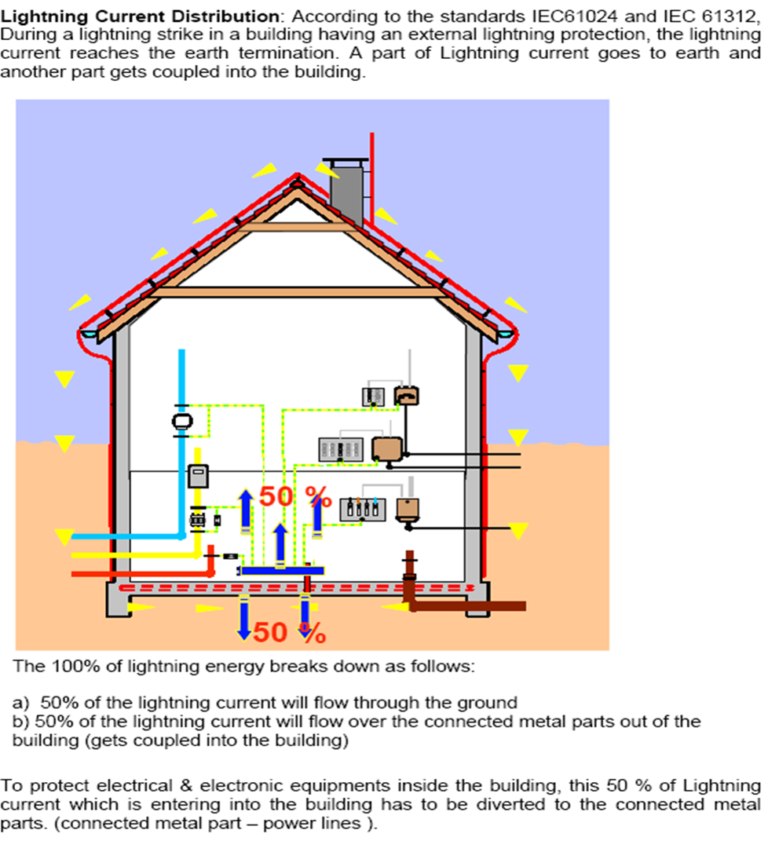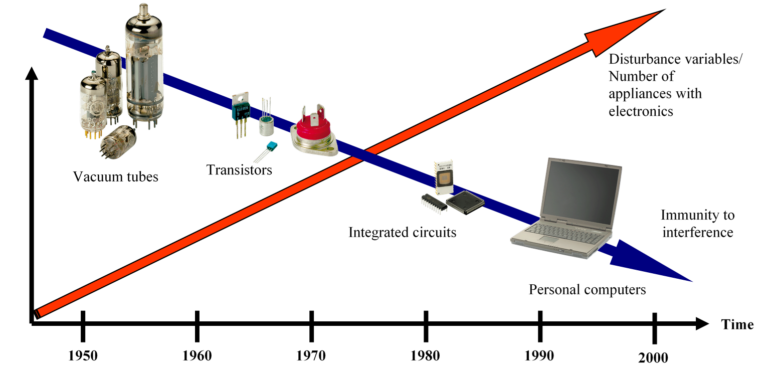Transients are more familiarly known as “surges” or “spikes”. The two important reasons for transients are lightning and switching. According to the standards IEC 61024 & IEC 61312, during a lightning strike on a building having an external lightning protection, the lightning current reaches the earth termination. A part of the lightning current goes to the earth and another part gets coupled into the building through the connected metal parts out of the building.
Lightning Surge : The largest voltage peaks in the low voltage consumer network are caused by lightning discharges. A direct lightning strike into a low voltage overhead line (L.T. Line) or data/TV cable (example: Telephone cable) can couple high partial lightning currents in an adjacent building. Electrical equipments in buildings at the end of low voltage overhead line sare at particular risk of damage caused by surges.
Even if lightning arrester is installed on a building, a local lightning strike creates additional high magnetic fields, which in turn induce high voltage peaks in line systems. Further, Inductive or galvanic coupling can cause damage within a radius of 1.5 to 2 kms around the lightning impact point.
As per standards, induction of lightning and discharge of the same takes place in micro seconds. Usually when we have a look at a lightning strike it comprises of 2 – 3 flashes and then we hear the thunder. Lightning impact on a network is hardly for 1.5 – 2.0 milli seconds. Within this time we never come across tripping of MCB’s, failure of fuses but of course we come across failure of our highly sophisticated equipment’s such as LCD / Plasma TV’s, DVD players, refrigerators, computers, Security Cameras etc.
Switching Surge: Switching of facility loads, opening and closing of disconnects on energized lines, switching of capacitor banks, re – closure operations and tap changing on transformers can cause transients. Poor or loose connections in the distribution system also can also generate transients.
Another common source, not commonly known, is neighboring business. If we share a transformer with the other users, any transient activity generated in his premises will be affecting our load, as both of the premises load are physically connected at the secondary of the same transformer.
Each time we turn on, turn off, load, or unload an inductive device, we produce a transient. Examples of inductive loads are motors, lifts, transformers, etc. The inductive “kick “ from a 5 HP motor turning on can produce a transient ( surge / spike ) in excess of 1 KV ( 1000 volts ). Even transformers can produce a large transient, particularly when energizing. Arcing can generate transients from a number of sources. Faulty contacts in breakers, switches and contactors can produce an arc when voltage jumps the gap. When this gap is “jumped” the voltage rises suddenly and the most common effect is an oscillatory transient.
As per IEC 61643 and NEC 2011, all sensitive equipments shall be provided with internal protection against the devastating effects of lightning with surge protection devices. This needs to be installed for all the lines like power lines, telephone, data, coaxial cables & load cells which are laid underground between the buildings and terminated at sensitive equipments like UPS, EPABX, CCTV etc to protect these sensitive equipments and downstream equipments connected from the UPS.
Surge Protection Devices ( SPD ) should be installed in co-ordination of Type 1 OR Type 1 + 2, Type 2 & Type 3 to ensure 100 % protection against transients. SPD’s are recommended at all the EB incomer at SSB for power lines, telephone, data& coaxial cables which are laid underground between the buildings and terminated at sensitive equipments like UPS, EPABX, CCTV etc to protect these sensitive equipments and downstream equipments connected from the UPS.
We have been supplying these SPDs to various Govt. departments like Airports Authority of India, PrasarBharati, Doordarshan, Railways and to many Industries like Ramco Cements, Ultratech Cements etc as per the partial reference list enclosed and they have derived great benefit of uninterrupted operations.
We are pleased to enclose the following :
- Soft copy of Surge Protection Devices Catalogue
- Partial List of Clients
Lightning risks
The lightning current can have very damaging consequences for the structures of buildings when they are struck by lightning. The solution is relatively easy to find: installation of lightning rods or possibly using natural components of the building.

With the progressive increase in the degree of sophistication of the Electrical & Electronic System due to very high proliferation of Computers and core banking, and various drives like VFD, the problems due to transient voltage surges are becoming common and big enough to merit attention. Infact, recent studies and analysis of failures of various sensitive Electrical & Electronic Components has lead to the conclusion that the Surges induced during Lightning and switching are one of the main reasons for these failures.


Need for Surge Protection Devices
By considering this scenario, Santosh Enterprises ( ELTECH Technologies ) have a wide range of solution against lighting and switching surges for your global requirement concerning with IS/IEC 62305 & IEC 61643.
Transient over voltages are generated
- Whenever a lightning strikes directly / in the near vicinity.
- As a consequence of different faults in the power system
- Switching on and off of different loads etc.
Typical products available in market like- it is mentioned in chart with their response time.

Within this response time our valuable equipment will be burned out so we have another product which is specially designing for this scenario known as Surge Protection Device ( SPD ) Now, by comparing with above

Another option available in the market is UPS.
The UPS systems generally offer a Type III Surge Protection which can handle low intensity surges only. However, if Type I & Type II Surge Protection Devices are not installed at the main incomer and at the sub-switch Board / Distribution Board level, Type III Surge Protection Devices provided at the load alone will not provide continuous protection to the asset. This is due to the fact, whenever a lightning strikes in the near vicinity or a switching surge comes into the system, if Type I & Type II are not provided at the main incomer or at the SSB / DB level, they will straight away come on to the end equipment and normally, at the first instance, the Surge Protection Device provided near the end equipment / load will operate and protect the asset in the process damaging itself. The asset will not be protected against any subsequent surges. If the surge is very severe the equipment could be damaged in the first instance itself in spite of having a Type III SPD.
It is very important to protect the sensitive electrical and electronic equipment against these transient voltage surges.
The transient voltage surges are broadly classified into two types i.e.:
- Lightning Surges (Handled by Type I SPDs)
- Switching surges (Handled by Type II SPDs)
The lightning surges bring very high amount of destructive energy into the system and hence, are potentially very dangerous. The Type I SPDs are designed to handle the Lightning current surges.
The switching surges are relatively frequent than the Lightning surges. Although they bring in relatively less energy into the system, but however, still strong enough to damage the sensitive electronics. The switching surges are handled by the Type II SPDs.
In addition, Type III SPDs are installed near to the sensitive / critical equipments. The Type III SPDs are meant to protect sensitive electronic equipments like measuring and control devices, Critical Instrumentation, Signaling etc, The residual voltage in these protectors is very low and are compatible with the respective electrical and electronic equipments connected.
Lightning Surge
The largest voltage peaks in the low voltage consumer network are caused by lightning discharges. A direct lightning strike into a low voltage over head line ( L.T. Line ) or data cable ( example : Telephone cable ) can couple high partial lightning currents in an adjacent building. Electrical equipment in buildings at the end of low voltage over head line are at particular risk of damage caused by surges.
Even if lightning arrester is installed on a building, a local lightning strike creates additional high magnetic fields, which in turn induce high voltage peaks in line systems. Inductive or galvanic coupling can cause damage within a radius of up to 2 km around the lightning impact point.
As per standards, induction of lightning and discharge of the same takes place in micro seconds. Usually when we have a look at a lightning strike it comprises of 2 – 3 flashes and then we hear the thunder. Lightning impact on a network is hardly for 1.5 – 2.0 milli seconds. Within this time we never come across tripping of MCB’s, failure of fuses but of course we come across failure of our highly sophisticated equipments such as LCD / Plasma TV’s, DVD players, refrigerators, computers, etc.
The incidence of damage, some of it considerable, caused by over voltage surges, has increased markedly in recent years. Why is this? The reason is not, as one might imagine, increased thunderstorm activity.
There are two reasons : One is the fact that nowadays our homes contain more sensitive electronic equipment than ever before. It is a long time since it was only the television set that was sensitive to surges. In the field of entertainment electronics, hi – fi installations, video recorders and DVD players, home PCs and peripherals are all vulnerable to over voltages on the low voltage network. In addition, there are electronically – controlled devices in almost every field of building technology, from the heating system and the telephone system to the alarm installation, as well as broad range of domestic and kitchen appliances from the sensor – controlled electric cooker to the programmable washing machine.
The other reason is the effect of technological progress. The electronic chips formerly used were more resistant to surges. What has now made the components more sensitive to surges was the reduction by a factor of ten in the spacing of the conductors. One result of this is that even relatively low voltage peaks of a few dozen volts on the data line are enough to destroy the interface card in an internet PC.

Switching Surge
Switching of facility loads, opening, and closing of disconnects on energized lines, switching of capacitor banks, re – closure operations and tap changing on transformers can all cause transients. Poor or loose connections in the distribution system can also generate transients. They may be caused by high winds, which can blow one power line into another or blow tree limbs into the lines causing arcing. You’ll probably be able to hear a buzzing sound and see sparks when the arc occurs, or you may even be able to smell the burnt.
Another common source, not commonly known, is neighboring business. If you share a transformer with the other users, any transient activity generated in his premises will be affecting your load as both of the premises load are physically connected at the secondary of the transformer.
Each time you turn on, turn off, load, or unload an inductive device, you produce a transient. Examples of inductive loads are motors, lifts, transformers, etc. The inductive “kick “ from a 5 HP motor turning on can produce a transient ( surge / spike ) in excess of 1 KV ( 1000 volts ). Even transformers can produce a large transient, particularly when energizing. Arcing can generate transients from a number of sources. Faulty contacts in breakers, switches and contactors can produce an arc when voltage jumps the gap. When this gap is “jumped” the voltage rises suddenly and the most common effect is an oscillatory transient.